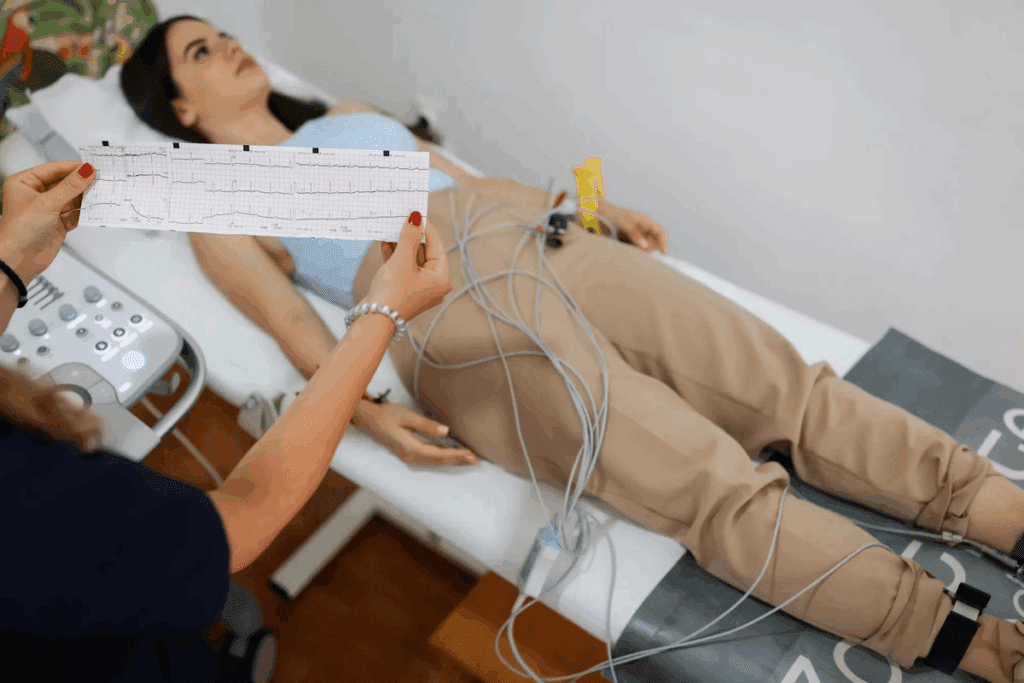Last Updated on November 25, 2025 by Ugurkan Demir

At Liv Hospital, we know how vital it is to manage heart diseases well. Beta blockers are a key class of medicines for treating heart issues like high blood pressure, heart failure, and irregular heartbeats.Find out 8 common beta blockers, their brand names, and how they help control blood pressure and heart rhythm.
We’ll look at the most often given beta blockers, their brand names, and how they help with blood pressure and heart health. The top ones are metoprolol, carvedilol, atenolol, propranolol, bisoprolol, labetalol, timolol, and nadolol.
Knowing about the different beta blockers and their uses helps patients manage their health better. This can lead to better heart health overall.

Beta blockers are key in treating heart problems. They are a type of medicine used for heart conditions.
Beta blockers block adrenaline’s effect on the heart and blood vessels. They stop adrenaline from working on beta receptors in the heart. This lowers heart rate and the heart’s contraction strength.
With less oxygen needed, the heart beats slower. This also lowers blood pressure.
Beta blockers help with many heart issues, including:
Common beta blockers are metoprolol (Toprol-XL, Lopressor), carvedilol (Coreg), and propranolol (Inderal LA).
Beta blockers are mostly safe but can have side effects like:
It’s important to know about these side effects. Talk to your doctor if you have concerns. Always take the medicine as directed and follow up with your doctor as scheduled.

It’s key for doctors to know the difference between selective and nonselective beta blockers. These drugs help with heart health and are used for many heart conditions.
Selective beta-1 blockers, like metoprolol, mainly work on the heart. They block beta-1 receptors. This helps avoid side effects like breathing problems.
Nonselective beta blockers, such as propranolol, affect both heart and other tissues. They block both beta-1 and beta-2 receptors. This can help in some cases but might cause more side effects.
The choice between selective and nonselective blockers depends on the patient’s health. For heart issues, selective blockers are often better. But for other problems, like migraines, nonselective blockers might be used.
Doctors consider many things when picking a beta blocker. They look at the patient’s health history and what they need. This way, they can choose the best treatment for each person.
Metoprolol, known as Toprol-XL and Lopressor, is a top choice for heart health in America. It’s used to treat high blood pressure, chest pain, and heart failure. This makes it a key part of heart care.
Metoprolol comes in two types: immediate-release (Lopressor) and extended-release (Toprol-XL). The immediate-release version is taken twice a day. The extended-release version is taken once a day. This lets doctors adjust treatment to fit each patient’s needs.
“The availability of both immediate and extended-release formulations of metoprolol provides clinicians with the flexibility to manage a wide range of cardiovascular conditions effectively,” says a leading cardiologist.
Metoprolol is mainly used for high blood pressure, chest pain, and heart failure. It’s known for lowering blood pressure and reducing chest pain. It’s also used for heart rhythm problems and to help patients survive after a heart attack.
Side effects of metoprolol include slow heart rate, tiredness, and dizziness. These effects are usually not serious but need watching. Regular visits to the doctor help adjust the dose and manage side effects.
Regular monitoring is essential to avoid bad effects and make sure metoprolol works well.
Carvedilol, also known as Coreg, is a special beta blocker. It has both alpha- and beta-blocking properties. This makes it very good at treating heart failure and high blood pressure.
Carvedilol’s alpha-blocking activity helps widen blood vessels. This reduces the heart’s workload. At the same time, its beta-blocking activity slows down the heart rate and makes it pump less forcefully. This lowers the heart’s need for oxygen.
This combination is great for heart failure patients. It boosts heart function without overloading it.
Studies have proven carvedilol helps heart failure patients live longer and go to the hospital less. It also lowers blood pressure in people with hypertension. Its dual-action mechanism is a key to managing heart and blood pressure issues.
Starting carvedilol with a low dose is important. This helps avoid side effects and ensures the patient can tolerate it. The first dose is 3.125 mg twice a day. This dose can be doubled every two weeks until the patient reaches the target dose or shows intolerance.
It’s key to watch for signs of low blood pressure, slow heart rate, and worsening heart failure during this time. Adjustments to the dose may be needed based on how the patient responds and tolerates the medication.
Atenolol, also known as Tenormin, is a cardioselective beta blocker used to treat high blood pressure. We’ll look at how well it works and compare it to other treatments.
Studies show atenolol is good at lowering blood pressure in people with hypertension. Its cardioselective nature helps it focus on the heart’s beta-1 receptors. This reduces heart rate and contraction strength, lowering blood pressure.
When we compare atenolol to other blood pressure medicines, several things matter. The table below shows how atenolol stacks up against other beta blockers.
| Medication | Cardioselectivity | Dosing Frequency | Side Effects |
| Atenolol (Tenormin) | Yes | Once daily | Fatigue, dizziness |
| Metoprolol (Lopressor) | Yes | Twice daily | Similar to atenolol |
| Propranolol (Inderal) | No | Twice to four times daily | Additional risk of bronchospasm |
For those taking atenolol long-term, regular check-ups are key. We need to keep an eye on how well it’s working and watch for side effects. We also consider the patient’s health and adjust treatment as needed.
In summary, atenolol is a good choice for treating high blood pressure, thanks to its cardioselective nature. Its once-a-day dose makes it easy for patients to stick to their treatment plan over time.
Propranolol, one of the first beta blockers, has grown to treat many conditions. We’ll look at its history, uses beyond heart issues, and the differences between its immediate and extended-release forms.
In the 1960s, propranolol was created to block beta-adrenergic receptors. It was a big step forward in treating heart diseases like high blood pressure and chest pain. Over time, it has been improved to work better and be easier for patients to take.
Today, propranolol is used for more than just heart problems. It shows how versatile it is as a medicine.
Propranolol is also good for other health issues. It helps with migraine prevention, essential tremors, and anxiety. Its ability to get into the brain makes it great for brain-related problems.
Because of its wide range of uses, propranolol is very useful in many medical situations. It’s not just for heart issues anymore.
Propranolol comes in two types: immediate-release and extended-release, or Inderal LA. The immediate-release is for quick needs like angina. The extended-release is for long-term use, like managing high blood pressure, and is taken once a day.
Which one to use depends on the health issue and the patient’s needs. It’s about how fast the medicine is needed versus how long it’s needed.
Beta blockers like bisoprolol and nebivolol help manage high blood pressure. They also help those who have trouble sleeping. Let’s look at why these medicines are special.
Bisoprolol and nebivolol target beta-1 receptors more than others. This means they work better on the heart. They are less likely to affect other parts of the body.
Nebivolol is special because it helps blood vessels relax. This helps lower blood pressure without hurting sleep.
Bisoprolol and nebivolol are good for those who can’t sleep well. They don’t usually cause bad dreams or trouble sleeping. This makes them a better choice for many patients.
Research shows nebivolol helps patients sleep better. This is important for their health and sticking to their treatment.
Both bisoprolol and nebivolol are good at lowering blood pressure. They also have fewer side effects. This makes them great for managing high blood pressure.
| Medication | Selectivity | Blood Pressure Control | Sleep Disturbances |
| Bisoprolol | High beta-1 selectivity | Effective | Less likely |
| Nebivolol | High beta-1 selectivity with vasodilation | Effective | Less likely |
In summary, bisoprolol and nebivolol are great for people with high blood pressure and sleep problems. Their special features and ability to control blood pressure make them excellent choices.
There are special beta blockers like labetalol, timolol, and nadolol. They have unique benefits for certain health needs. These drugs are valuable in specific medical situations.
Labetalol is a beta blocker that also blocks alpha-1 adrenergic receptors. It’s great for quickly lowering blood pressure in emergencies. It works well without causing the heart to beat too fast.
Timolol is famous for treating glaucoma. But it’s also used for high blood pressure and chest pain. It helps lower eye pressure and also helps the heart.
Nadolol works for 24 hours, so you only need to take it once a day. It’s mainly for high blood pressure and chest pain. Its long action helps keep treatment consistent.
| Beta Blocker | Primary Use | Unique Characteristic |
| Labetalol (Trandate) | Hypertensive Emergencies | Alpha and beta blocking activity |
| Timolol | Ophthalmic (Glaucoma) and Systemic Hypertension | Non-selective beta blockade |
| Nadolol (Corgard) | Hypertension and Angina | Long-acting, once-daily dosing |
In conclusion, labetalol, timolol, and nadolol are special beta blockers. They have unique benefits for certain health needs. Knowing about them helps doctors make better choices for heart health.
Choosing the right beta blocker is key for managing heart conditions. We’ve looked at many beta blockers, like metoprolol and carvedilol. Each has its own benefits and uses.
Healthcare providers must think about each patient’s needs when picking a beta blocker. This includes looking at any other health issues and possible side effects. There are many beta blockers to choose from, and the right one depends on the patient.
Choosing a beta blocker is a careful process. It involves looking at how selective the blocker is, the dose needed, and the patient’s health. Knowing about the different types of beta blockers helps doctors make the best choice for each patient.
In the end, finding the right beta blocker can greatly improve a patient’s life. It can lead to better health and a better quality of life for those with heart conditions.
Beta blockers are medicines that slow the heart rate. They also make the heart’s contractions weaker. This helps lower blood pressure and improve heart health.
Common beta blockers for high blood pressure include metoprolol (Toprol-XL, Lopressor) and atenolol (Tenormin). Others are propranolol (Inderal LA), bisoprolol (Zebeta, Monocor), and nebivolol (Bystolic).
Selective beta blockers, like metoprolol and atenolol, mainly affect the heart. Nonselective beta blockers, such as propranolol, affect both the heart and lungs.
Side effects of beta blockers include feeling tired, dizzy, and short of breath. To manage these, you might need to adjust your dosage or switch medications. Sometimes, treating underlying conditions helps too.
Yes, beta blockers are used for heart failure, angina, certain heart rhythm issues, and migraines.
Yes, nebivolol (Bystolic) is known for being better for sleep compared to other beta blockers.
Choosing the right beta blocker depends on your health, medical history, and what you’re treating. Your doctor will consider your heart health, other medications, and possible side effects.
Beta blockers can be taken with other drugs, but always tell your doctor about all your medications. This helps avoid bad interactions.
Taking beta blockers long-term means regular checks on your blood pressure and heart rate. Your doctor might need to adjust your treatment plan over time.
No, stopping beta blockers suddenly is not safe. It can cause withdrawal symptoms and make heart problems worse. Always taper off under a doctor’s guidance.
Subscribe to our e-newsletter to stay informed about the latest innovations in the world of health and exclusive offers!